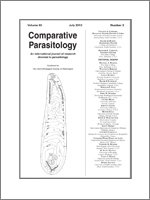Pseudocorynosoma constrictum Van Cleave, 1918 (Polymorphidae) is an endoparasite that infects a variety species of waterfowl from North America. Specimens of P. constrictum were recovered in central Mexico from 7 species of definitive host as well as from the freshwater amphipod Hyalella azteca, its intermediate host. In total, 69 amphipods were infected with 15 acanthella and 58 cystacanths. Morphologically, the adults and cystacanths of P. constrictum possess triangular spines covering most of the anterior part of the trunk, they have a slight constriction separating the anterior and posterior regions of the trunk, and they have an ovoid or cylindrical proboscis with a slightly swollen region covered with 16 longitudinal rows of 10 hooks each. Sequences of the mitochondrial coding gene cytochrome c oxidase were generated for 21 samples of P. constrictum (14 adults, 3 acanthella, and 4 cystacanths). The genetic divergence estimated among specimens was very low, ranging from 0 to 3%. All these sequences were aligned with 18 other taxa, representing 6 genera of Polymorphidae, forming a data set of 39 taxa with 655 nucleotides. The maximum parsimony and maximum likelihood trees indicated that the 21 sequences of P. constrictum formed a well-supported clade. The morphological evidence, in combination with the genetic divergence, plus the systematic position in the phylogenetic trees, indicated that all the samples of P. constrictum belong to the same lineage. The presence of P. constrictum in 7 species of waterfowl from central Mexico could be explained as a result of host-sharing, as the result of these hosts occurring in sympatry, and by the fact that they feed on the same species of amphipod known to harbor cystacanths. This study also confirms that a complete life cycle occurs in central Mexico wetlands.
How to translate text using browser tools
1 July 2013
First Record of the Intermediate Host of Pseudocorynosoma constrictum Van Cleave, 1918 (Acanthocephala: Polymorphidae) in Central Mexico
Martín García-Varela,
Carlos-Daniel Pinacho-Pinacho,
Ana-Lucia Sereno Uribe,
Berenít Mendoza-Garfías
ACCESS THE FULL ARTICLE

Comparative Parasitology
Vol. 80 • No. 2
July 2013
Vol. 80 • No. 2
July 2013
Acanthocephala
adult
cox 1
cystacanth
genetic divergence
maximum likelihood
maximum parsimony




